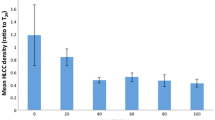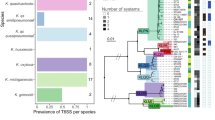Abstract
The Burkholderia cepacia complex (Bcc) is a group of ten closely related species associated with life-threatening infection in cystic fibrosis (CF). These bacteria are highly antibiotic resistant, with some strains transmissible, and in a subgroup of patients, they can cause a rapid and fatal necrotising pneumonia. The Bcc organisms produce a range of exoproducts with virulence potential, including exopolysaccharide, proteases and lipases. Many members of the Bcc are also capable of epithelial cell invasion, although the mechanism(s) involved are poorly understood. This study investigates a role for Bcc lipase in epithelial cell invasion by Bcc strains. Lipase activity was measured in eight species of the Bcc. Strains that produced high levels of lipase were predominantly from the B. multivorans and B. cenocepacia species. Pre-treatment of two epithelial cell lines with Bcc lipase significantly increased invasion by two B. multivorans strains and one B. cenocepacia strain and did not affect either plasma membrane or tight junction integrity. Inhibition of Bcc lipase production by the lipase inhibitor Orlistat significantly decreased invasion by both B. multivorans and B. cenocepacia strains in a concentration-dependent manner. This study demonstrates the extent of lipase production across the Bcc and establishes a potential role for lipase in Bcc epithelial cell invasion.




Similar content being viewed by others
References
LiPuma JJ, Spilker T, Gill LH, Campbell PW 3rd, Liu L, Mahenthiralingam E (2001) Disproportionate distribution of Burkholderia cepacia complex species and transmissibility markers in cystic fibrosis. Am J Respir Crit Care Med 164:92–96
Speert DP (2002) Advances in Burkholderia cepacia complex. Paediatr Respir Rev 3:230–235
Mahenthiralingam E, Baldwin A, Vandamme P (2002) Burkholderia cepacia complex infection in patients with cystic fibrosis. J Med Microbiol 51:533–538
Mahenthiralingam E, Urban TA, Goldberg JB (2005) The multifarious, multireplicon Burkholderia cepacia complex. Nat Rev Microbiol 3:144–156
Govan JR, Brown PH, Maddison J, Doherty CJ, Nelson JW, Dodd M, Greening AP, Webb AK (1993) Evidence for transmission of Pseudomonas cepacia by social contact in cystic fibrosis. Lancet 342:15–19
LiPuma JJ, Dasen SE, Nielson DW, Stern RC, Stull TL (1990) Person-to-person transmission of Pseudomonas cepacia between patients with cystic fibrosis. Lancet 336:1094–1096
Johnson WM, Tyler SD, Rozee KR (1994) Linkage analysis of geographic and clinical clusters in Pseudomonas cepacia infections by multilocus enzyme electrophoresis and ribotyping. J Clin Microbiol 32:924–930
Chernish RN, Aaron SD (2003) Approach to resistant gram-negative bacterial pulmonary infections in patients with cystic fibrosis. Curr Opin Pulm Med 9:509–515
Bevivino A, Dalmastri C, Tabacchioni S, Chiarini L, Belli ML, Piana S, Materazzo A, Vandamme P, Manno G (2002) Burkholderia cepacia complex bacteria from clinical and environmental sources in Italy: genomovar status and distribution of traits related to virulence and transmissibility. J Clin Microbiol 40:846–851
Corbett CR, Burtnick MN, Kooi C, Woods DE, Sokol PA (2003) An extracellular zinc metalloprotease gene of Burkholderia cepacia. Microbiology 149:2263–2271
Sist P, Cescutti P, Skerlavaj S, Urbani R, Leitao JH, Sa-Correia I, Rizzo R (2003) Macromolecular and solution properties of Cepacian: the exopolysaccharide produced by a strain of Burkholderia cepacia isolated from a cystic fibrosis patient. Carbohydr Res 338:1861–1867
Chung JW, Altman E, Beveridge TJ, Speert DP (2003) Colonial morphology of Burkholderia cepacia complex genomovar III: implications in exopolysaccharide production, pilus expression, and persistence in the mouse. Infect Immun 71:904–909
Sokol PA, Darling P, Woods DE, Mahenthiralingam E, Kooi C (1999) Role of ornibactin biosynthesis in the virulence of Burkholderia cepacia: characterization of pvdA, the gene encoding L-ornithine N(5)-oxygenase. Infect Immun 67:4443–4455
Visser MB, Majumdar S, Hani E, Sokol PA (2004) Importance of the ornibactin and pyochelin siderophore transport systems in Burkholderia cenocepacia lung infections. Infect Immun 72:2850–2857
Hutchison ML, Poxton IR, Govan JR (1998) Burkholderia cenocepacia produces a hemolysin that is capable of inducing apoptosis and degranulation of mammalian phagocytes. Infect Immun 66:2033–2039
Straus DC, Lonon MK, Hutson JC (1992) Inhibition of rat alveolar macrophage phagocytic function by a Pseudomonas cepacia lipase. J Med Microbiol 37:335–340
Allison DG, Goldsbrough MJ (1994) Polysaccharide production in Pseudomonas cepacia. J Basic Microbiol 34:3–10
Berka RM, Gray GL, Vasil ML (1981) Studies of phospholipase C (heat-labile hemolysin) in Pseudomonas aeruginosa. Infect Immun 34:1071–1074
Vasil ML, Krieg DP, Kuhns JS, Ogle JW, Shortridge VD, Ostroff RM, Vasil AI (1990) Molecular analysis of hemolytic and phospholipase C activities of Pseudomonas cepacia. Infect Immun 58:4020–4029
McKenney D, Allison DG (1995) Effects of growth rate and nutrient limitation on virulence factor production in Burkholderia cepacia. J Bacteriol 177:4140–4143
McKevitt AI, Woods DE (1984) Characterization of Pseudomonas cepacia isolates from patients with cystic fibrosis. J Clin Microbiol 19:291–293
Lonon MK, Woods DE, Straus DC (1988) Production of lipase by clinical isolates of Pseudomonas cepacia. J Clin Microbiol 26:979–984
Stehr F, Kretschmar M, Kroger C, Hube B, Schafer W (2003) Microbial lipases as virulence factors. J Mol Catalysis B Enzymatic 22:347–355
Slomiany BL, Kasinathan C, Slomiany A (1989) Lipolytic activity ofCampylobacter pylori: effect of colloidal bismuth subcitrate (De-Nol). Am J Gastroenterol 84:1273–1277
Piotrowski J, Czajkowski A, Yotsumoto F, Slomiany A, Slomiany BL (1994) Sulglycotide effect on the proteolytic and lipolytic activities of Helicobacter pylori toward gastric mucus. Am J Gastroenterol 89:232–236
Burns JL, Jonas M, Chi EY, Clark DK, Berger A, Griffith A (1996) Invasion of respiratory epithelial cells by Burkholderia (Pseudomonas) cepacia. Infect Immun 64:4054–4059
Martin DW, Mohr CD (2000) Invasion and intracellular survival of Burkholderia cepacia. Infect Immun 68:24–29
Cieri MV, Mayer-Hamblett N, Griffith A, Burns JL (2002) Correlation between an in vitro invasion assay and a murine model of Burkholderia cepacia lung infection. Infect Immun 70:1081–1086
Chiu CH, Ostry A, Speert DP (2001) Invasion of murine respiratory epithelial cells in vivo by Burkholderia cepacia. J Med Microbiol 50:594–601
Duff C, Murphy PG, Callaghan M, McClean S (2006) Differences in invasion and translocation of Burkholderia cepacia complex species in polarised lung epithelial cells in vitro. Microb Pathogenesis 41:183–192
Tomich M, Herfst CA, Golden JW, Mohr CD (2002) Role of flagella in host cell invasion by Burkholderia cepacia. Infect Immun 70:1799–1806
Coenye T, Vandamme P, LiPuma JJ, Govan JR, Mahenthiralingam E (2003) Updated version of the Burkholderia cepacia complex experimental strain panel. J Clin Microbiol 41:2797–2798
Mahenthiralingam E, Coenye T, Chung JW, Speert DP, Govan JR, Taylor P, Vandamme P (2000) Diagnostically and experimentally useful panel of strains from the Burkholderia cepacia complex. J Clin Microbiol 38:910–913
Pratt J, Cooley JD, Purdy CW, Straus DC (2000) Lipase activity from strains of Pasteurella multocida. Curr Microbiol 40:306–309
Caraher E, Duff C, Mullen T, Mc Keon S, Murphy P, Callaghan M, McClean S (2007) Invasion and biofilm formation of Burkholderia dolosa is comparable with Burkholderia cenocepacia and Burkholderia multivorans. J Cyst Fibros 6:49–56
Maher S, McClean S (2006) Investigation of the cytotoxicity of eukaryotic and prokaryotic antimicrobial peptides in intestinal epithelial cells in vitro. Biochem Pharmacol 71:1289–1298
Ehrhardt C, Collnot EM, Baldes C, Becker U, Laue M, Kim KJ, Lehr CM (2006) Towards an in vitro model of cystic fibrosis small airway epithelium: characterisation of the human bronchial epithelial cell line CFBE41o. Cell Tissue Res 323:405–415
Ehrhardt C, Kneuer C, Fiegel J, Hanes J, Schaefer UF, Kim KJ, Lehr CM (2002) Influence of apical fluid volume on the development of functional intercellular junctions in the human epithelial cell line 16HBE14o−: implications for the use of this cell line as an in vitro model for bronchial drug absorption studies. Cell Tissue Res 308:391–400
Artursson P, Karlsson J (1991) Correlation between oral drug absorption in humans and apparent drug permeability coefficients in human intestinal epithelial (Caco-2) cells. Biochem Biophys Res Commun 175:880–885
Gilligan PH (1991) Microbiology of airway disease in patients with cystic fibrosis. Clin Microbiol Rev 4:35–51
Hadvary P, Lengsfeld H, Wolfer H (1988) Inhibition of pancreatic lipase in vitro by the covalent inhibitor tetrahydrolipstatin. Biochem J 256:357–361
Ryding U, Renneberg J, Rollof J, Christensson B (1992) Antibody response to Staphylococcus aureus whole cell, lipase and staphylolysin in patients with S. aureus infections. FEMS Microbiol Immunol 4:105–110
Rollof J, Braconier JH, Soderstrom C, Nilsson-Ehle P (1988) Interference of Staphylococcus aureus lipase with human granulocyte function. Eur J Clin Microbiol Infect Dis 7:505–510
Gilchrist CA, Houpt E, Trapaidze N, Fei Z, Crasta O, Asgharpour A, Evans C, Martino-Catt S, Baba DJ, Stroup S, Hamano S, Ehrenkaufer G, Okada M, Singh U, Nozaki T, Mann BJ, Petri WA Jr (2006) Impact of intestinal colonization and invasion on the Entamoeba histolytica transcriptome. Mol Biochem Parasitol 147:163–176
Gottlich E, de Hoog GS, Yoshida S, Takeo K, Nishimura K, Miyaji M (1995) Cell-surface hydrophobicity and lipolysis as essential factors in human tinea nigra. Mycoses 38:489–494
Miskin JE, Farrell AM, Cunliffe WJ, Holland KT (1997) Propionibacterium acnes, a resident of lipid-rich human skin, produces a 33 kDa extracellular lipase encoded by gehA. Microbiology 143:1745–1755
Davis CP, Avots-Avotins AE, Fader RC (1981) Evidence for a bladder cell glycolipid receptor for Escherichia coli and the effect of neuraminic acid and colominic acid on adherence. Infect Immun 34:944–948
Acknowledgements
The authors would like to express their gratitude to Dr. Dieter Gruenert, California Pacific Medical Center Research Institute, San Francisco, CA for kindly providing us with the 16HBE14o− and CFBE41o− cell lines. In addition, we would like to thank Dr. Peter Vandamme at the Laboratory for Microbiology, Ghent University, Ghent Belgium for providing the Bcc strains. This work was funded by the Post-graduate R&D Skills Programme (PRDSP) and the Programme for Research in Third Level Institutions (PRTLI) administered by the Higher Education Authority (HEA), Ireland.
Author information
Authors and Affiliations
Corresponding author
Rights and permissions
About this article
Cite this article
Mullen, T., Markey, K., Murphy, P. et al. Role of lipase in Burkholderia cepacia complex (Bcc) invasion of lung epithelial cells. Eur J Clin Microbiol Infect Dis 26, 869–877 (2007). https://doi.org/10.1007/s10096-007-0385-2
Published:
Issue Date:
DOI: https://doi.org/10.1007/s10096-007-0385-2




